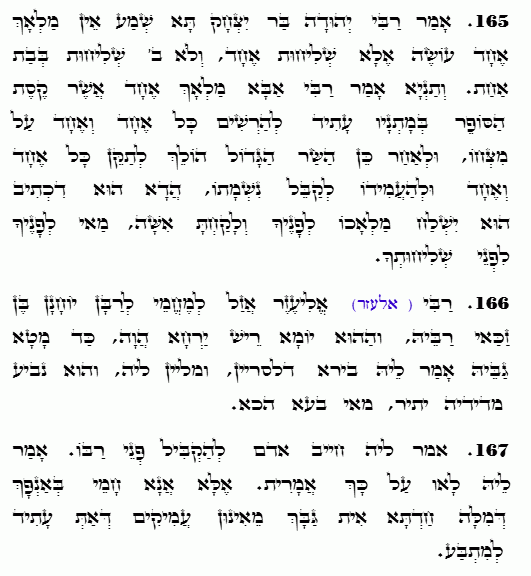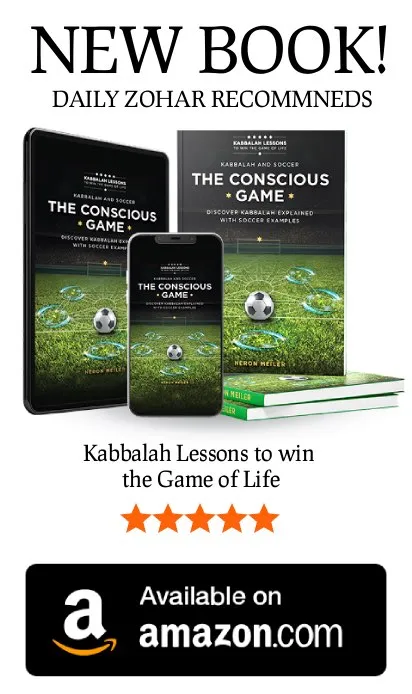Daily Zohar # 4710 – Chayei Sarah – No single angel performs two missions at once
Daily Zohar 4710

Hebrew translation:
166. רַבִּי [אֶלְעָזָר] אֱלִיעֶזֶר הָלַךְ לִרְאוֹת אֶת רַבָּן יוֹחָנָן בֶּן זַכַּאי רַבּוֹ, וְאוֹתוֹ הַיּוֹם הָיָה רֹאשׁ חֹדֶשׁ. כְּשֶׁהִגִּיעַ אֵלָיו, אָמַר לוֹ, הַבְּאֵר שֶׁמְּנֻקֶּה מִכָּל טִנֹּפֶת, וּמְמַלְּאִים אוֹתוֹ וְנוֹבֵעַ מִשֶּׁלּוֹ יוֹתֵר, מָה רוֹצֶה כָּאן?
167. אָמַר לוֹ, חַיָּב אָדָם לְהַקְבִּיל פְּנֵי רַבּוֹ. אָמַר לוֹ, לֹא כָּךְ אָמַרְתִּי, אֶלָּא אֲנִי רוֹאֶה בְפָנֶיךָ שֶׁדָּבָר חָדָשׁ יֵשׁ אֶצְלְךָ מֵאוֹתָם הָעֲמֻקִּים שֶׁאַתָּה עָתִיד לִשְׁאֹל.
.
Zohar Chayei Sarah
Continued from previous DZ
#165
Rabbi Yehuda, son of Rabbi Yitzchak, said: “Come and hear: No single angel performs two missions at once.” The explanation is that there are two distinct missions here: 1. To resurrect the body to life in its grave. 2. Bring the body to the Land of Israel, where it will be reunited with the soul. The question arises: “No single angel performs two missions; how, then, is this accomplished?”
Rabbi Abba answers: “We have learned that a single angel, the one with the ink-horn at his side, identified as Gabriel, will inscribe each person with a mark upon their forehead.” This means that Gabriel is responsible for preparing and restoring the body for resurrection.
Afterward, “the great minister,” identified as Metat–, will perfect each individual and prepare them to receive their soul.
This is the meaning of the verse: “הוּא יִשְׁלַח מַלְאָכוֹ לְפָנֶיךָ וְלָקַחְתָּ אִשָּׁה לִבְנִי מִשָּׁם” “He will send His angel before you, and you shall take a wife” (Genesis 24:7). What does “לְפָנֶיךָ” “before you” mean? It teaches that before your mission, the Holy One, Blessed be He, sends an angel first to prepare the body. Then, Metat– brings it to receive its soul. This division of tasks aligns with the principle that no single angel performs two missions.
#166
Rabbi Eliezer went to see his teacher, Rabbi Yochanan ben Zakkai, on the day of Rosh Chodesh. When he arrived, Rabbi Yochanan said to him:
“A well that is seen by others, filled with drawn water, and yet flows even more from its own source—what does it seek here?”
Rabbi Eliezer replied: “A person is obligated to visit his teacher on Rosh Chodesh.”
Notes:
Rabbi Yochanan likens Rabbi Eliezer to a well that is filled from external sources but also overflows with its own waters. Despite continually learning from others, this metaphor highlights Rabbi Eliezer’s spiritual depth and ability to give back.
The imagery suggests a cycle of receiving and giving, illustrating how students draw from a teacher’s wisdom and, through their own understanding, contribute even more.
The timing of the visit on Rosh Chodesh symbolizes new beginnings and the opportunity for spiritual renewal. By visiting his teacher, Rabbi Eliezer aligns himself with the flow of divine energy that Rosh Chodesh represents, drawing further inspiration from his spiritual mentor.
#167
Rabbi Yochanan told Rabbi Eliezer: “A person is obligated to visit his teacher on Rosh Chodesh.” Rabbi Yochanan replied: “That is not what I meant when I asked, ‘What are you seeking here?’ Rather, I see on your face that you have something new to share—one of the deep secrets you are about to ask. That is what I meant. Since you are so great, what do you seek from me?”
Notes:
This passage illustrates the depth of the teacher-student relationship, emphasizing that even the greatest students continue to seek wisdom from their teachers. Rabbi Yochanan’s acknowledgment of Rabbi Eliezer’s growth shows how true teachers nurture and celebrate their students’ spiritual achievements.
The exchange also highlights the collaborative nature of Torah study, where both teacher and student inspire and challenge each other. It serves as a reminder of the importance of humility, connection, and the pursuit of deeper understanding in our spiritual journeys.
{||}

 Previous: Chayei Sarah
Previous: Chayei Sarah

